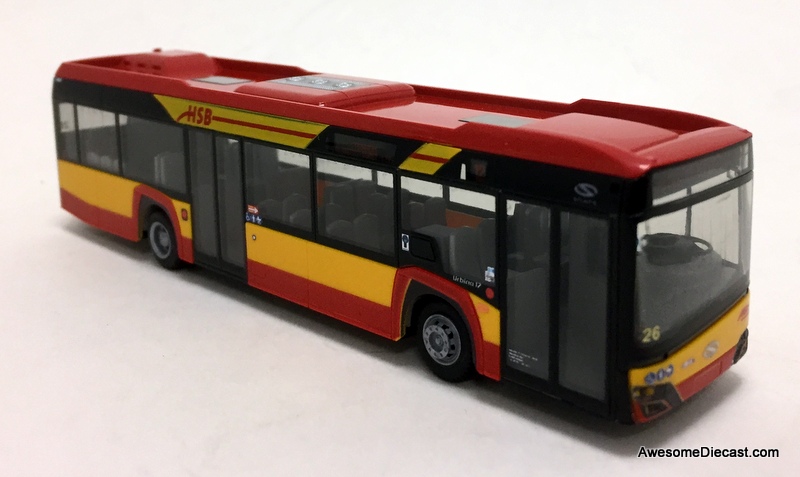Rietze
Rietze 1:87 Solaris Urbino 12: VOR Transport
This model is made from ABS plastic The mirrors for this model are in the box Verkehrsverbund Ost-Region (VOR) is the largest transport association in Austria and has been ensuring comprehensive...

Detailed plastic model bus
Solaris Urbino is a series of low-floor buses and low-entry doorway intercity buses, powered by diesel drive engines and alternative fuel (CNG, gas and biogas, hybrid and electric), produced by the Polish company Solaris Bus & Coach in Bolechowo near Poznań in Poland. Currently produced models are of the fourth generation, and by 2019 the production will start for the fifth.
Solaris Urbino buses series have been very successful in the market, as evidenced by many orders in Poland and abroad.
The first bus from Solaris Urbino series rolled off the production line in Bolechowo in mid-1999. It was a Solaris Urbino 12 which in the second half of the year debuted two new models known as the Solaris Urbino 15 and Solaris Urbino 18, and in 2000 the series was joined by the Solaris Urbino 9. They have been designed by Neoplan with the participation of designers from Berlin IFS Designatelier which designed all of the next generation of the models.
In the second half of 2001 and 2002 the models of the second generation were ready. The 9-metre model was then replaced by the Solaris Urbino 10. Since 2005, the buses in the Solaris Urbino series are all third generation. The third series is distinguished by a characteristic depth front bow, which allows the driver better visibility at bus stops. Special orders were delivered, in the second-generation. During the IAA Nutzfahrzeuge in Hannover, which was held from September 25 - October 2, 2008, at the same in Poland the Transexpo Trade Fair in Kielce in October 2008, had presented the prototype model of the Solaris Urbino 12 New Edition generation 3.5. While maintaining the body of the third generation, the buses in the series received a new refurbished interior from the upcoming new fourth generation of buses. Where the interior had been improved by stylistic and illumination of the interior. Also a new instrument panel and steering wheel was included for the easy operation of the bus.
The shortest vehicle of the series is Solaris Alpino 8.9 LE, which has a length of 8.9 meters and from the rest of the models in the series is narrower by 15 centimetres, and for this reason received the name Solaris Urbino 8.9 LE for marketing reasons.
In 2012, two new low-floor models were added to the series which were the Solaris Urbino 12.9 and Solaris Urbino 18.75.
The Solaris Urbino series also includes the Solaris Urbino 12 Low Entry (from 2005) and the Solaris Urbino 15 LE (from 2008), which was built preferably for companies for intercity and commuter routes.
The Solaris Urbino bus series has a bus which is built for urban and interurban commutes which is the Solaris Urbino 12 Ü (from the German Überland), which made its debut at the IAA Nutzfahrzeuge in Hanover in September 2012. Instead of the classic box type style the bus had a bow-like cabin and the MAN D20 engine. The capacity for seated passengers increased to 44 in the front of the bus.
In 2014 at the world premiere at the IAA in Hannover and at the Polish premiere at Transexpo Trade Fair in Kielce the new model of the Solaris Urbino series bus was shown, designed from the beginning in order to meet the needs of passengers and companies better.
The Hanauer streetcar GmbH (HSB) is the transport operation of the Hessian town of Hanau ( Frankfurt Rhine-Main ). Despite the name, there is no more tram traffic in Hanau today.
Since 1944 and the cessation of trams, buses have been the only mode of transport operated regularly by the HSB. With the three vehicles, which could still be kept roadworthy after the air raids, driving operations were resumed on January 2, 1946, initially as a makeshift with a line between Kesselstadt and the Freigerichtviertel . Only students and skilled workers were promoted. The route was then extended to Hauptbahnhof - Kesselstadt - Beethovenplatz - Lamboystraße . So he served the most densely populated parts of Hanau after the destruction of the city center. From December 8, 1947 there was again scheduled bus traffic for the general public. After a brief, temporary collapse as a result of currency reform 1948 now passenger numbers rose steadily, and extra lines have been established. Since 1950 the HSB has been part of the Hanauer Stadtwerke .